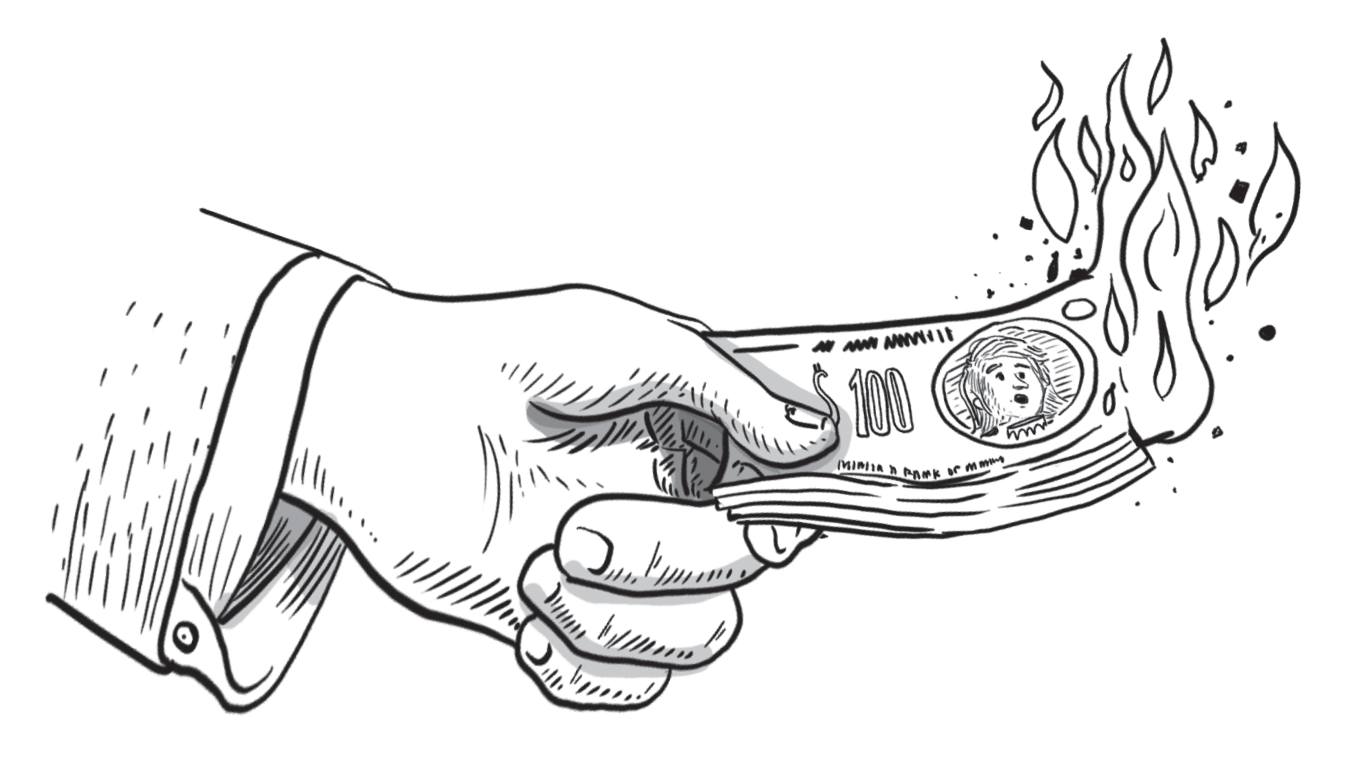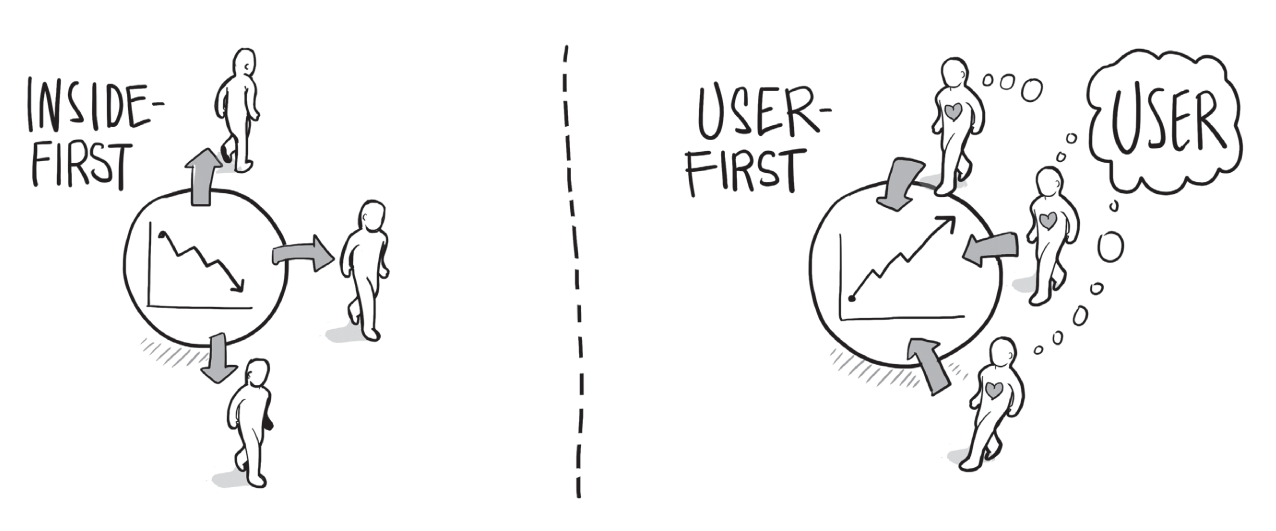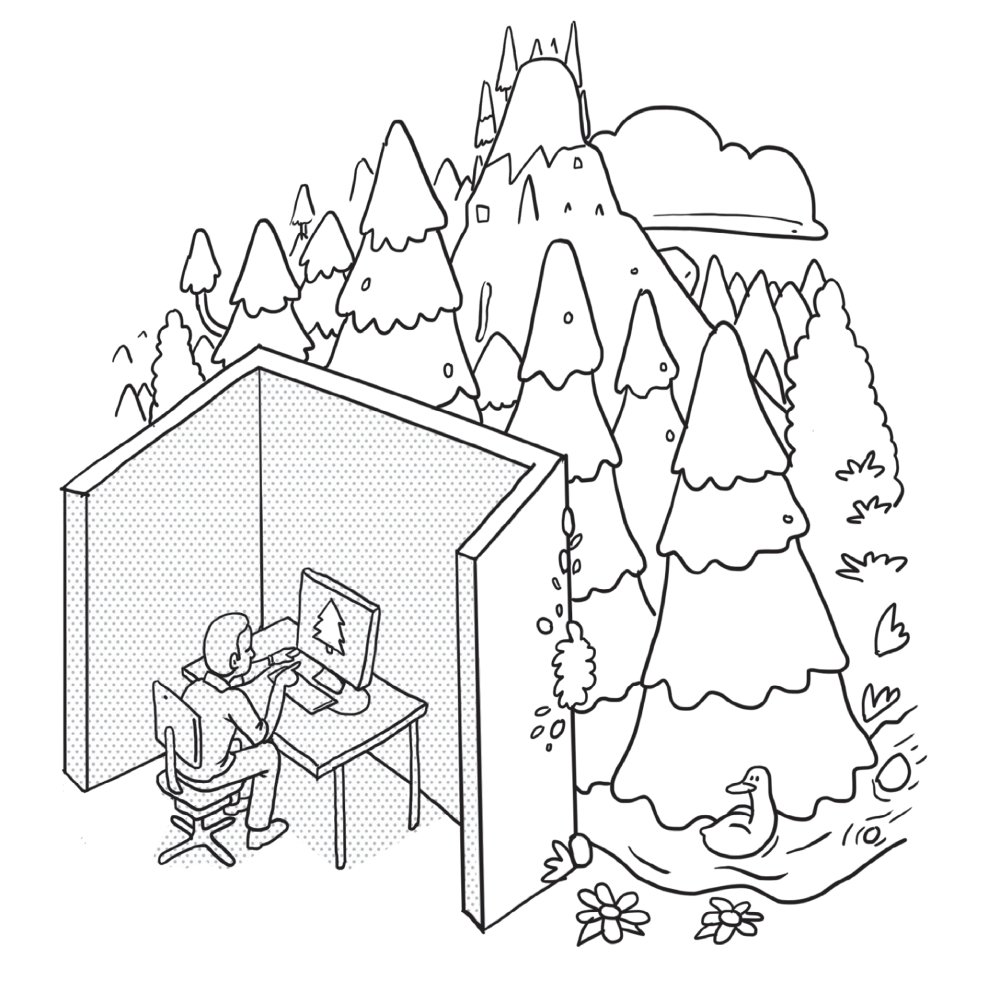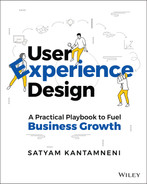CHAPTER 05
BUSINESS INSANITY: Doing the same thing and expecting a different result

The following insanity plays out every day in the business world: In their pursuit of the best user experience, organizations are making the same mistakes over and over again, without realizing what they are doing wrong.
It’s not uncommon to consistently see businesses hiring a couple of designers or a design agency or bring in a speaker and assuming they are on the right path of unlocking the business value that the business data is referring to. It takes a lot more than that, but to start with they need to understand the following.
User Experience Design: The Secret Is in the Semantics
“User experience design” (UX Design) is a deliberately structured term. “User” precedes “experience,” and “design” is at the end. This ordering reflects best practices. However, most organizations jump to designing around the capabilities of their technology before considering either their users or their experiences.
Forty percent of products are developed without any input from end users. Not coincidentally, 35% of new ideas and start‐ups fail due to poor product‐market fit. Organizations burn through billions of dollars with no clear outcome, a waste compounded by lost time and opportunity cost. The modus operandi needs to change quickly if organizations are to be relevant and grow shareholder value.
Developing the wrong solution is costly. But companies that are mindful of the “user before experience before design” principle will build products that users actually want and need as the sequencing protects them.
Inside‐First vs. User‐First
In the pursuit of developing and shipping products quickly, most organizations make the mistake of innovating in the wrong direction. They approach the project “inside‐first.”

In inside‐first organizations, internal stakeholders leverage their business instinct, technology, processes, and sales machines to try to design and engineer a solution for their end users. Typically, they frame the problem by stating:
- We have a major release in a few weeks; can we clean up the user experience?
- Our competitor just launched a mobile product; can we create one, too?
- Our sales partners told us that our product looks old; how can we redesign it?
- We have engineers ready to build; how quickly can you make the wireframes?
- Can we build an analytics product like this other company’s?
- The CPO said we need to add these screens; can you design them?
The above statements demonstrate inside‐first thinking—and no UX designer, design team, or UX design firm can truly add value in this context, as the goal here is to design and create artifacts—quickly.
In contrast, user‐first organizations curate a collective, deep understanding of their users and their experiences before making any business, design, engineering, marketing, sales, or product decisions. They frame the problem by stating:
- Can we research our users’ needs that we aren’t currently serving and include them in our strategic planning?
- Our users are having difficulty with the onboarding experience; can we design and iterate further?
- We’ve identified a user problem; can you help research further and prototype a solution we can test?
- How can we align all our different departments’ workflows so we can deliver a seamless user experience?
Effective innovation and marketplace disruption stems from organizations that are User‐First. Unfortunately, too many organizations make the mistake of approaching innovation “Inside first”, thereby making the same mistake every time while expecting different results.
Small Design vs. BIG DESIGN
As stated earlier, design is the trailing component of user experience design but important nonetheless. Too many organizations are caught up in the craft of design while neglecting the larger discipline of DESIGN. While craft is a critical element of the process, it’s helpful to metaphorically think in terms of a biodiverse ecosystem: Consider the forest as a whole before focusing on the individual trees.

Visionary SpaceX founder Elon Musk uses the title of chief designer. It signals DESIGN: the realization that everything in this world, business or personal, from arranging a house party, to engineering a company reorganization, to transporting humans to Mars—everything is DESIGNED.
Organizations that are built for BIG DESIGN are destined to be more thoughtful and resilient than organizations that focus on small design craft because their larger pursuit is to deliver value to the user and their ecosystem by consistently understanding the user’s intent, needs, and goals while connecting these dots with the business needs and outcomes.
Remember, that every system being designed has users and related ecosystems, with their related constraints and opportunities. Adopting a BIG DESIGN philosophy also sets the foundation for an egalitarian organizational culture in which DESIGN is the purview of every teammate who cares about users and their experience. BIG DESIGN thinks holistically about experiences.
Experience Debt: Death by a Thousand Cuts
In the pursuit of shipping a feature as quickly as possible, companies are frequently forced to make compromises. This often translates into not resolving all of the experience problems they’ve identified for specific users. Even when they’ve developed good solutions to the problems, time or technology constraints prevent them from building those solutions out.
Each deferred solution becomes a debt the business owes to the user. In most pragmatic organizations, this is acceptable and normal. However, when these debts start accumulating and compounding, it can become detrimental to the business as a whole.
Organizations carrying a high experience debt are easily disrupted by competitors, who have the advantage of observing the problems, starting from scratch, and building the product or service correctly. In addition, user loyalty is highly compromised; they become open to trying other products that offer a better experience.
Unfortunately, too many businesses are unaware that they are accumulating experience debt. The debt is a ticking time bomb that will explode even with the most well‐intentioned user experience design goals.
